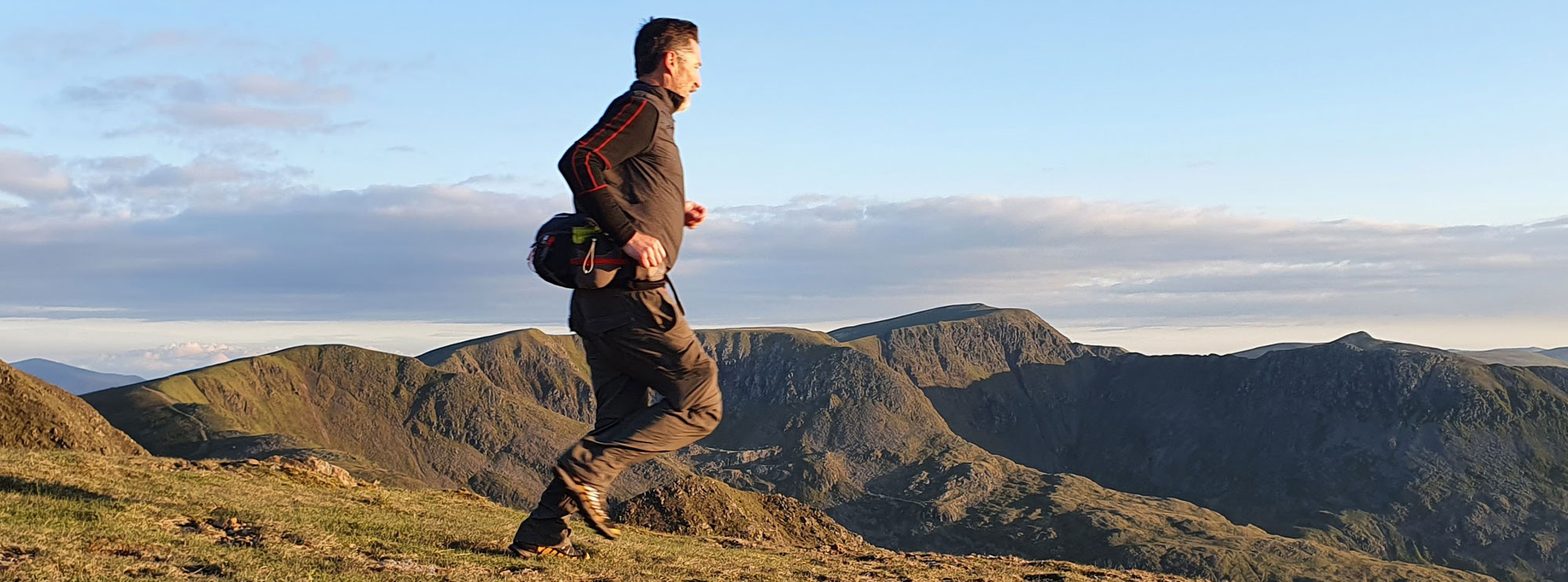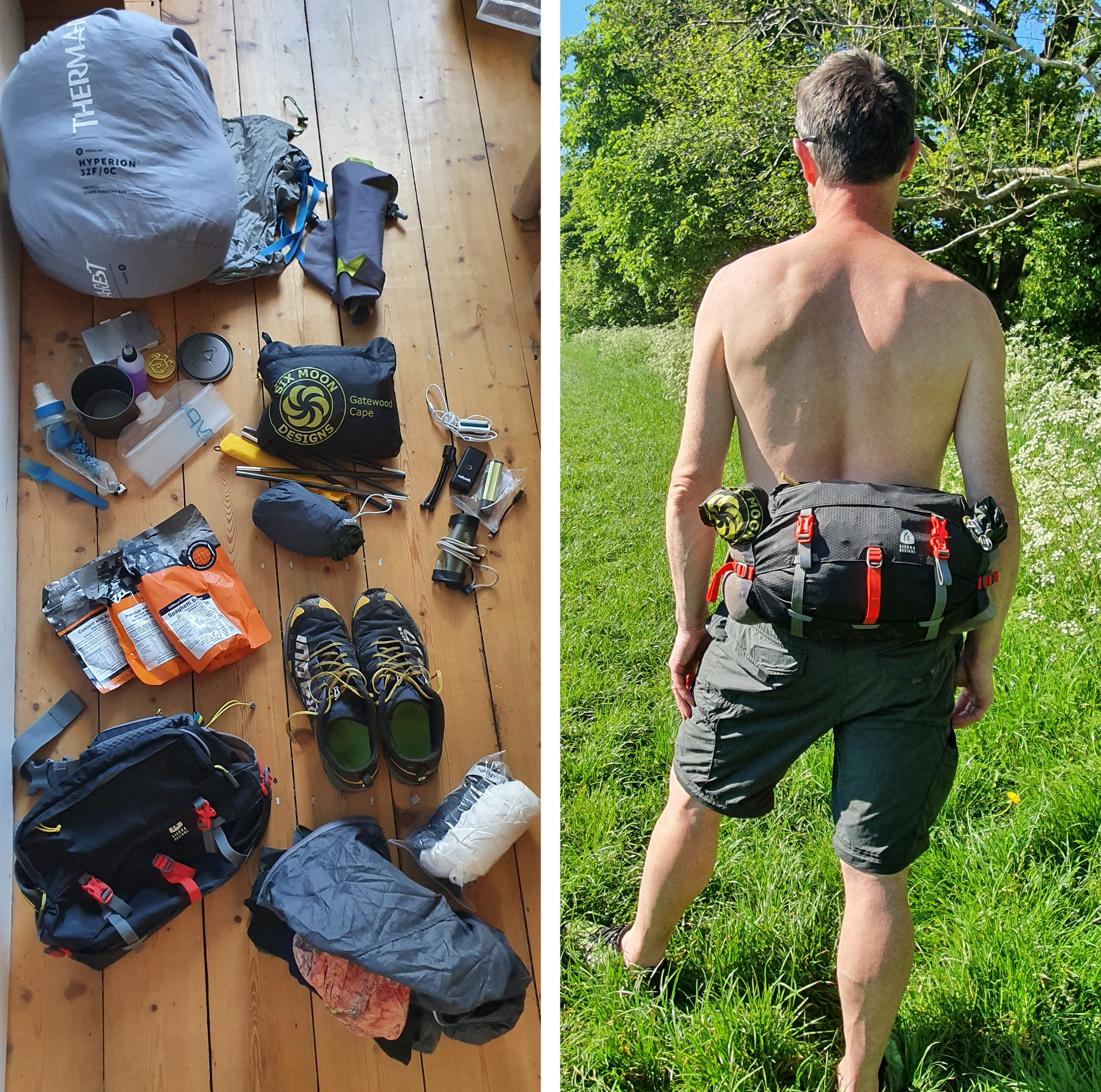How to Fastpack with a Bum Bag
Posted by Norman Hadley on May 26, 2022

“The more constraints one imposes, the more one frees oneself” - Igor Stravinsky.
The Genesis of an Idea
In the first three months of 2021, leisure travel was disallowed to contain the coronavirus. Again, I was exiled from my beloved Lakeland fells. True, I was much luckier than most - the Bowland hills are on my doorstep - but I dreamed of the day I would be able to run the Cumbrian ridges again.
The dream spread wings and took flight. Could I set my sights higher than just a return to the status quo? What if, instead of a couple of hours on a Friday afternoon, I ran for two days, with a high camp in between? No timetable - just the rolling ridges and the security of having food and shelter to hand, able to pitch up whenever I wanted. It sounded the perfect expression of freedom.
But everything I’d read about the niche crossover sport of fastpacking looked pretty gruelling. Running with a rucksack seemed sweaty and cumbersome. And who wants to lie shivering on a sheet of bubble wrap at night? It looked freeing but not exactly fun.
So I decided my lockdown challenge, instead of learning Italian or perfecting a sourdough recipe, was to gather together an ultralight setup that made both running and camping a pleasure. To make it a sporting challenge, I decided from the start that there would be no rucksack at all. I’ll say that again in case you think it’s a typo - no rucksack.
As if that wasn’t hard enough, two other complications arose. The first was that, having not backpacked in thirty years, I had no legacy kit worth having - I had to start from scratch. The other problem was that Covid made gear shops a no-go area. The Ultralight Outdoor Gear site was a lifesaver. It spoke my language, with everything sorted lightest to heaviest. I also found helpful guidance by telephone and email.
Working from The Outside In
The first decision was both the easiest and the one that would make all the other decisions far harder than they would have been. I bought the biggest bum bag UOG offered - the Sierra Trails Flex Lumbar 7-10. I now had to cram everything - shelter, sleep system, cook system, food - into a space little bigger than a rugby ball. How hard could it be?
For me, a bumbag was the only plausible solution. Almost without stopping, I could add or subtract layers, or grab snacks from the zipped pocket on the waist band. And the low centre-of-gravity is a bonus for stability.
Sleeping insulation was bound to be the single largest item. It was pretty clear that no synthetic fill was going to compete with down for compressibility. I toyed with the idea of a quilt but I am a restless sleeper so I decided a bag would be warmer. I compiled startlingly nerdy graphs of comfort ratings, weights and stowed volumes. The winner for me was the Thermarest Hyperion 32. You’d need to be a brave soul to actually kip out in 32F/0C in it, but it’s an excellent three-season bag and it comes with a compression sack that squashes it down superbly. A thin silk liner adds a little warmth and protects the bag from the sweat and filth of the first day's run.
Sleeping pads were next on the decision-tree. Again, compact storage was the primary goal. I gravitated towards Klymit’s X-frame - it’s only 260 grams and rolls up to the size of a beer can. I particularly like its novelty; in a world of identical ironing-board shapes, it looks bizarre - more hole than pad. The theory goes that the holes allow your sleeping bag extra space to loft down into. And I’ve been impressed by it - for warm-weather camping, at least.
I went all round the houses on stoves. I tried a light gas stove but the weight of the canister proved a significant burden in the bag. At the other end of the scale, I experimented with Esbit tablets but found them fiddly, slow and smelly. I eventually settled on a tiny meths burner and folding pot-stand from Speedster. UOG sold me a Toaks 550ml titanium pot which is an ideal size for both drinks and for rehydrating meal pouches.

That just left the tiny detail of a shelter. Trial fits in the bum bag showed it would have to be really compact to stow in the hip pocket. Hardly any tents, even the ultra light ones, had poles that folded short enough. Conversely, because I am in my fifties and not as supple as I once was, I discounted anything I couldn’t sit up in or cook in. Likewise, anything single-skinned with a groundsheet was eliminated on condensation grounds.
From that almost impossible brief, the only solution I could devise was the Six Moons Gatewood cape with a Terra Nova Moonlite bivi bag to keep the sleeping bag dry. I don’t run with poles so I bought a Six Moons carbon pole that folds down to 280mm and weighs less than a Mars bar. A pack of six pegs was about the same weight again. The pole and pegs go in the main body of the bumbag, while the cape and bivi bag go in the hip pouches, so they can be stowed wet if needed.
Carrying quantities of water isn’t really convenient so hydration is mostly an on-the-go affair. A Katadyn BeFree filter tucks into the waistband pocket so I can safely drink whenever I cross streams. In camp, a 2 litre Platypus bag covers all my cooking and rehydration needs.
With everything assembled, base weight is 2.4kg, which is 5lb 5oz for older readers. Full disclosure - that’s with wearing the thin merino layer and stashing buffs and gloves in trouser pockets. With 24-hours worth of food inside, the bag is a decent heft but it sits stably and, after the first mile, I can forget it’s any different from a day bag.
Real-World Testing
So far the kit has performed superbly. I’ve been on four trips so far, ranging from running bare-chested in a heatwave to far, far cooler weather. Admittedly, I’ve not been troubled by rain or high winds so far - I’m sure that day will come. The inaugural trip, over St Sunday Crag and Fairfield, was written up in the September 2021 issue of the Great Outdoors magazine. Subsequent outings have involved high camps on Scoat Fell, Esk Pike and Scafell Pike. All four camps were over 800m, to get the authentic mountain feel. I’m looking forward to plenty more outings in 2022, and I have some ideas for an even more remarkable setup. Because it’s all about the challenge of the next horizon, isn’t it?

